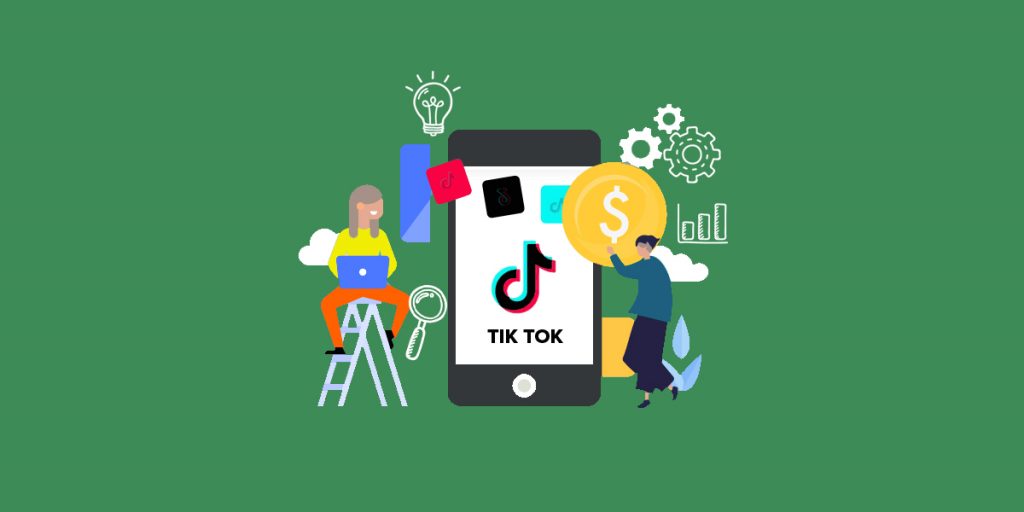If you’ve opened a social network in the past 12 months, you’ve probably seen a video post saved on TikTok in your news feed. With nearly 800 million monthly active users (June 2021), TikTok is leaving the role of rising star and is now establishing itself as a social media giant alongside Instagram, Snapchat, or Facebook. This crazy rise raises a question more and more frequently among marketing directors and managers of SMEs: should I use TikTok for my business?
Here are some arguments and examples of TikTok for business marketing that may help you answer that question.
Table of Contents
TikTok in a few figures
Since its launch in 2016 and more particularly since the end of 2018, TikTok has recorded very rapid growth:
- The TikTok app has been downloaded more than 2 billion times worldwide
- As of Q1 2020, TikTok has been downloaded 315 million times
- A TikTok User spends an average of 52 minutes per day on the app
Not just a network of teenagers
You might think that TikTok is an app that only young people under the age of 20 use? Not really anymore. This prejudice is gradually being erased under the impetus of an increasingly aging audience:
- In the US, the share of 18-24-year-olds on TikTok fell from 41.1% in January 2020 to 35.3% in April, while the share of 25-34-year-olds increased from 22.4% to 27.4%.
TikTok is therefore becoming a general public application that is attracting more and more Millenials.
Why is this initial information important from a marketing perspective?
The increase in the average age of its users means that their average purchasing power is also on the rise. Is TikTok already getting a little more interesting for your business? Let’s go on.
Should your business use TikTok?
There are several factors that come into play before planning to create a TikTok business strategy.
- What are your priority marketing goals?
- Does your audience match that of TikTok, mostly 15-30-year-olds?
- Is your brand able to deliver spontaneous, creative, and entertaining video content?
For example, if you sell consumer products or clothing, chances are some of your audience uses TikTok on a daily basis. On the other hand, if your target customer is a business manager (in B2B, for example) who doesn’t have time to watch people dance for 52 minutes every day, then maybe LinkedIn or Facebook will be more interesting.
How to use TikTok for a business?
There are three ways to use TikTok for your business promotion:
- Create a brand-specific channel and upload relevant videos to your business
- Use influencers to open your content to a wider audience, without necessarily having a TikTok account
- Pay to Advertise Using New TikTok Marketing Options
The following arguments and examples will allow you to more accurately assess whether TikTok can help you develop your corporate social media strategy.
3 Reasons (and examples) to use TikTok with your business

#1. The opportunity to catch a new wave first
In a digital environment where everything goes very fast, the opportunity for a company to create a significant gap with its competitors does not often occur. With TikTok still being ignored by many companies, you have the rare opportunity to use the ” first-mover ” advantage. If you think that developing a TikTok community will be complex today, imagine what it will be like when all of your competitors are already using it.
For example, The Washington Post built a TikTok audience of 1/2 million users in almost a year by posting light, informal content to its TikTok account. We’re not talking about case studies or white papers, but 15-second videos. This quickly acquired reach allows them today to position themselves with a new audience in which other newspapers have not yet bothered to take an interest (which they will probably regret in the years to come).
#2. Target other segments of your audience differently
All of the big social networks we use today started out by attracting a younger audience.
When it first came into being, Instagram was also used primarily by teens and young adults. Today, all age groups use it, as well as … 25 million companies. Regarding the demographics of its users, the statistics presented above show that the same phenomenon is happening with TikTok.
“Ok, but young people are not my main target today.”
This is the case of the company Specialized Bikes, whose flagship product, high-end bikes, is aimed at enthusiasts and professionals with a certain purchasing power. But just because their top-grossing product isn’t aimed at the TikTok user demographics doesn’t mean other products aren’t.
The company has therefore created new content exclusive to TikTok. This entertaining and inspiring content is more focused on their “lifestyle” customers who would buy transport bikes and other related products rather than their primary users, such as athletes.
The result: The content on offer works with the demographic they are trying to attract and has generated 300,000 subscribers for 5 million likes.
#3. Generate visibility in an original way with influencers
TikTok offers challenges that you can use for your business even without a TikTok account. Thanks to its many new influencers, the platform offers innovative promotion possibilities such as hashtag challenges in a market much less saturated than Instagram.
A hashtag challenge is initiated when you encourage TikTok users to create or recreate content and add your brand, blog, or product hashtag to it.
For example, the Guess brand was one of the first companies to launch a hashtag challenge. She encouraged TikTok users to film themselves wearing Guess’s new jeans line with the hashtag #InMyDenim, which generated 50 million impressions. We don’t know exactly the number of additional Denim sales generated as a result of this hashtag challenge, but we imagine that no brand would do without.
For SMEs that do not have a Guess audience, the idea is, therefore to promote a hashtag challenge through influencers. To get a feel for the most influential people in your niche, you can start with a simple keyword search in the #TikTok search bar.
Just get started!
Although they had a good initial audience, the three brands illustrated in this article are also part of a TikTok account without a subscriber or video. If your customer base is likely to use TikTok, it would probably be worth a try. Take the time to observe popular trends in your industry, identify the content that the younger part of your audience likes to consume on TikTok, and get started!







